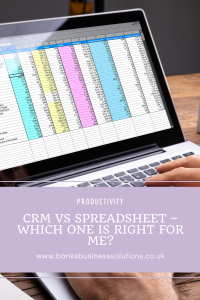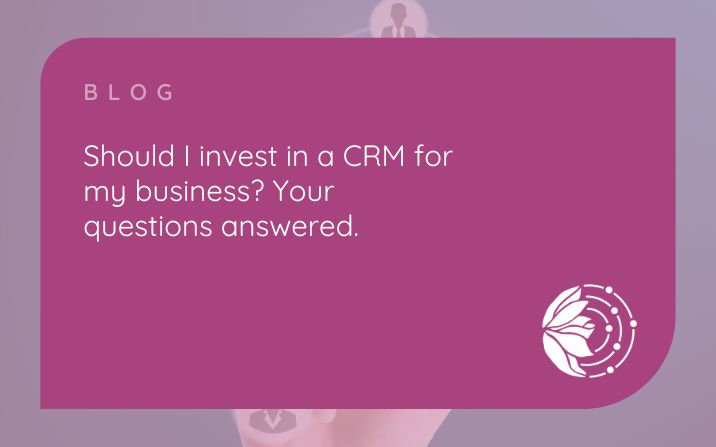CRM vs Spreadsheet – which one is right for me?
Keeping track of your clients and their data can be tricky, especially when you’re offering multiple services or packages. It’s vital to have relevant and up-to-date information on your clients and what they want from you to keep customer service high and your stress levels low.
When you’re starting to lose track of clients and their data, it’s a good idea to put a customer relationship manager (CRM) system in place. But it doesn’t have to be a put together package that you buy into. Sometimes a spreadsheet is just as good.
You’ll know that you need a CRM when:
- You’ve lost track of leads
- Client details are incorrect
- You outsource to a VA who needs access to client data
- You want to track client spend and other metrics
Obviously, this involves a lot of client data and you need to be sure that however you store and use this information complies with GDPR.
Cost is certainly a factor when it comes to choosing a CRM
And that is why a spreadsheet is often a good way to go, especially when you’re first starting out.
If tracking metrics isn’t a priority and you’re simply looking for an easier way to keep track of your clients and leads, a spreadsheet can do that for you. And it’s free as part of an Office365 or GSuite subscription too.
The search function in spreadsheets makes it quick and easy to get to the information you need, and by using a few formulas you can use colour coding or tags to track changes and data you want to keep on top of.
I’ve been using spreadsheets for a few years now and although they’ve been the simplest way for me to get started with tracking clients and their information, I’m now finding that there’s too much data for a spreadsheet to handle and I need something specifically designed for customer management.
Another problem I’ve found with spreadsheets is that it can be time-consuming to create reports and get the information I need at a glance for things like planning email marketing campaigns and streamlining processes.
Customer relationship management systems don’t have to be expensive
When it’s cost that’s putting you off getting a ready-made CRM, you might be surprised that there are free systems available to you. Each with functions that a spreadsheet just can’t do such as setting reminders in your calendar for important tasks and even sending out emails to your entire client list.
Each CRM system will have different features, with some part of a premium package, but key things to be looking out for are:
Customer management – the ability to use segmentation to put your clients into groups, such as by service, or package rate. You might see this labelled as “contact management”, it’s the same thing.
Email integration – a lot of CRMs are now email management systems too, enabling you to control everything from one dashboard and keep track of the engagement and sales data more easily.
File syncing – being able to upload and share key documents is a great feature to have, files like contracts, terms of agreement, etc.
GDPR compliant data storage – essential for ensuring that your client’s data is protected in accordance with data protection regulations.
Mobile CRM – most systems have a mobile app you can tap into wherever you are, useful if you lose internet connection and need access to your customers details to let them know.
Reports – CRMs can track the metrics you want them to and create colourful reports that present the information you need to know at a glance. Useful if you’re not a statistics person and prefer easy-to-read information.
Customer support – there’s a lot to take in when moving to a new CRM, so knowing the customer service you’re likely to receive is a good indicator to base your decision on.
So now you know what to look out for in a CRM (and what you can’t get with a spreadsheet), what are good CRM systems to be looking at?
Capsule
Capsule’s free plan allows you to have 250 contacts in the management system, and access for 2 people (perfect for you and your virtual assistant). The features are limited compared to the paid plans but for the basics you can’t go too far wrong with task management, calendar, ability to set and track milestones, segmentation and email integration included.
HubSpot
HubSpot is a well known digital marketing company that has provided free advice and information that’s been invaluable to many business owners. Their free CRM reflects the marketing knowledge they’ve put behind it with many useful features including a dashboard that allows you see your sales funnel at a glance and log every activity automatically via social media and email, making lead generation easier than ever.
This CRM is free and allows you to have up to “1,000,000 contacts, users, and storage“ with free customer support tools like live chat, bots and email integration.
MailChimp
I’ve been a big advocate of MailChimp as an email marketing service for a while now and I’m excited about it’s move toward being a CRM system. It makes sense when they already have customer information, segmentation and email features already available! Now known as an “all in one marketing platform”, MailChimp offers a free account that includes basic reports and simple recommendations but if you want more advanced features, you will need to opt for a paid plan.
So that’s my rundown of customer relationship management systems and my suggestions for CRMS that might be useful to you. There’s nothing wrong with keeping things simple and on a spreadsheet, but when you start to lose track or need to collaborate with others, I highly suggest making the move to a free CRM.

